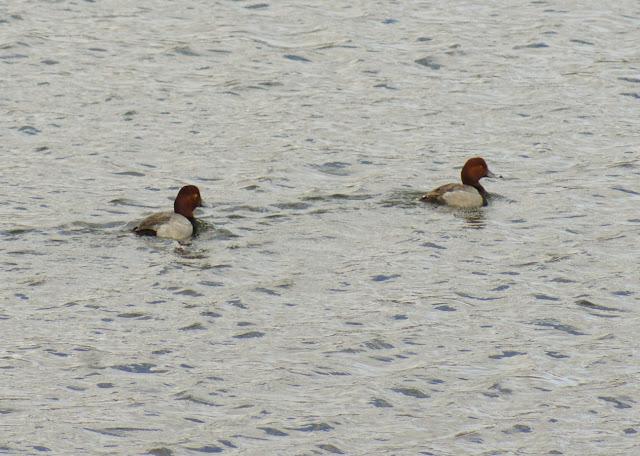
We continued along the river, eyes darting back and forth between the water and the bustling tree canopies above us. There were lots of handsome Yellow-Rumped Warblers darting around, but Swallows provided the real action. There were hundreds of them swooping, soaring, and diving above the river, and they maintained their relentless extermination of all airborne insects for the duration of our trip. The Rough-Winged Swallows and Bank Swallows made up the majority, but Tree Swallows, Cliff Swallows, and even a few Barn Swallows were also visible in the feeding frenzy. I could not take any presentable Swallow pictures, so this pair of nice, easy-going Mallards provided the consolation prize.
As the Salt River approached the Granite Reef dam, it becomes much wider and deeper. The number and diversity of the waterfowl really picks up, although American Coots are still the largest constituency. We had some nice looks at Cinnamon Teal, Redheads, Ring-Necks, and Canvasback.
Across the lake, this sole Eared Grebe, fully decked-out in his naval uniform/breeding regalia, patrolled the final stretch of accessible water, making sure that if anybody crossed the buoys, they'd do it by swimming.
"Abandon All Boats, Ye Who Enter Here"
We started to run out of room along the waterfront and found another path leading through the thick undergrowth, now looking for Warblers, Flycatchers, and whatever made its home in the gloomy woods. Along with your standard dose of Abert's Towhees, there were a lot of Phainopeplas in the area. I was surprised to see them not only adorning the treetops, but also foraging deep into the undergrowth and near the ground--not really the sort of behavior to expect from silky Flycatchers. This was also the first time I've been able to observe Phainopepla nests. Perhaps the added demands of parenthood abolished the birds' normal scruples with low-level feeding.
Here a female sits atop her stately teacup nest.
The woods were very thick at times, and unfortunately the willow trees and cottonwoods often intermingled with thorny mesquite and ironwood trees to make navigation a slow and painstaking process. But the dense foliage served its purpose, even as it blocked out what little sunlight there was. There were Cardinals, Brewer's Sparrows, White-Crowns, tons of Yellow-Rumped Warblers, and even some Wilson's Warblers.
(I said great looks not great photos)
Throughout the day we found two pairs of calling Bullock's Orioles, whose fiery orange, yellow, and white couldn't be suppressed even by the thoroughly overcast sky.
The Yellow-Rumped Warblers like to form ferocious gangs. They roamed around terrorizing tree canopies with no consideration or restraint. If you're small, invertebrate, and have more than four legs...don't let these gangs catch you. They would move through areas with astonishing numbers and quickness, cleaning out the local insect populations and chattering all the while. It was hard not to get caught up in the momentum at times, both for ourselves and for other birds. This Hermit Warbler gave up his life of isolation and was recruited into the cartel, where he did his share of the work in decimating the insect population.
The Hermit Warbler was a first for Pops and me. Even though they do migrate through the area, it was a totally unexpected sighting. When the yellow head catches the light, it's a very striking bird.
As we approached the dam, the woodlands became more and more thin. The trees were shorter and the bird species again shifted. Along the woody margin we saw Chipping Sparrows, White-Winged Doves, and a Northern Harrier. Some Lazuli Buntings provided another great surprise, though the subsequent photographic pursuit was in vain. At least I photographed some Javelina. That's just as good right..?
Pedestrians are barred access to the dam itself, and a large worksite on the south side of the river forced us to take an additional detour to get around to the west side. We followed a canal for part of the way and got to observe the chaparral and its inhabitants, including some exceedingly red House Finches, just as the sun finally started to break through the clouds.

We continued to walk along the chaparral, keeping our eyes and ears peeled (ouch!) for any bird signs. With our concentration on the marginal trees and shrubs, it was a great bit of fortune that I happened to look down just in time to avoid stepping on this coiled Glossy Snake. Upon close inspection, it appeared that this snake was dead already. Maybe it was just feeling super sluggish with the lack of warm light, or maybe it's better at playing dead than Elvis. Either way, we moved it off the road and continued in our loop back to the parking lot.
We decided to retrace our steps to where we had last seen the Lazuli Buntings, hoping they'd make another appearance. There was no more luck on that account, but it was a felicitous decision, for in the Buntings' place we encountered a brazen Olive-Sided Flycatcher. Of course, he was perched atop the tallest tree he could find, but a break in the clouds allowed for some quick shots, and we were treated to some dexterous in-flight displays as he charged from perch to perch.
It was a great trek, and Granite Reef definitely deserves its fine reputation as one of the premier birding areas in Maricopa County. With Granite Reef on the east side, Tres Rios on the west side, Glendale Recharge Ponds to the north and the Gilbert Water Ranch to the south, Phoenix-area birders can go in any direction and find great birds.










